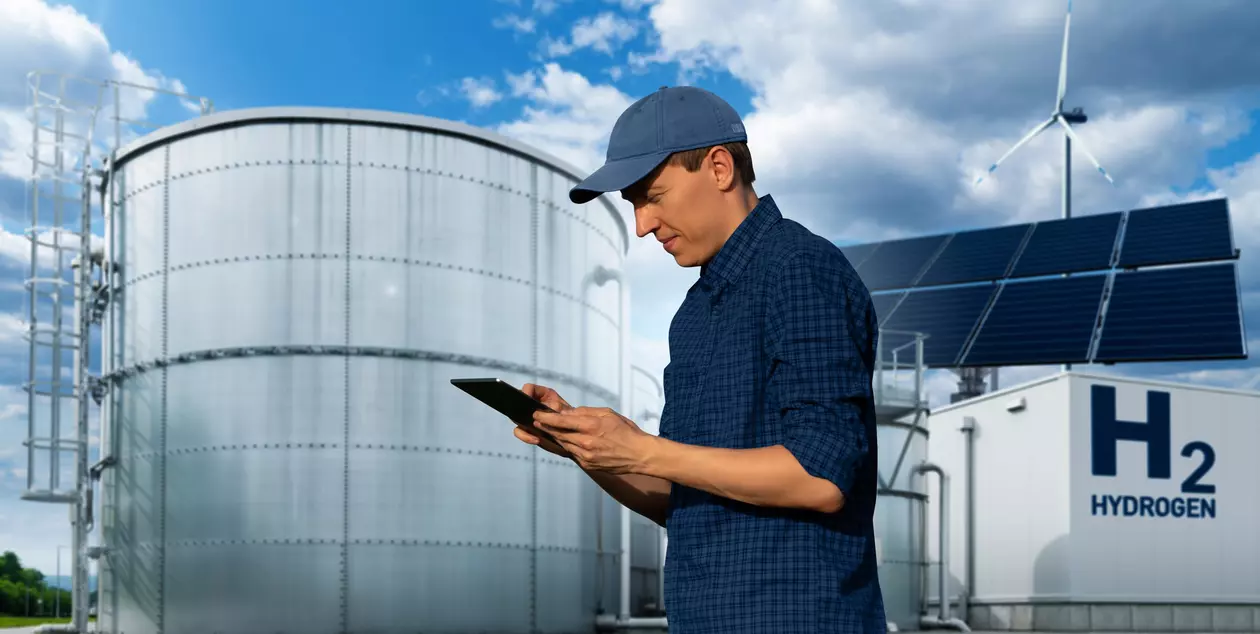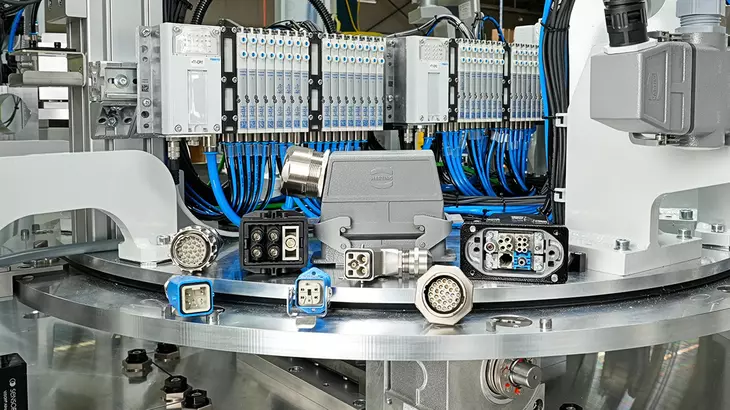Hydrogen Technology
Our sustainable solutions for the hydrogen industry offer connectivity in a wide range of sectors. Our modular and individually configurable components and our customised system solutions are both relied on wherever monitoring and control is required in the production, storage, distribution and filling of hydrogen.

Hydrogen technologies include processes and systems that produce and utilise hydrogen as an energy source. These include the production of hydrogen through electrolysis, the storage and transport of hydrogen and its use in fuel cells to generate electricity. These technologies offer a clean alternative to fossil fuels and contribute to the reduction of CO₂ emissions.
What is Hydrogen Technology?
Hydrogen technology is a promising approach to the realisation of a sustainable energy future. It covers three key areas:
Production: Hydrogen can be produced in a number of ways, one of the most common being electrolysis. Electrolysis uses an electric current to split water into hydrogen and oxygen. This process can be powered by renewable energy sources such as wind, solar or hydroelectric power, making it a green and sustainable method. Other production methods include steam methane reforming (SMR), which extracts hydrogen from natural gas, and biomass gasification, which converts organic materials into hydrogen. Advances in technology are continually improving the efficiency and reducing the cost of these production methods.
Storage and transport: To ensure safety and efficiency, hydrogen's properties require special storage and transportation methods. Hydrogen can be stored as a gas at high pressure, as a liquid at very low temperatures, or in chemical compounds that release hydrogen on demand. Each method brings their own advantages and challenges. For example, storing hydrogen as a gas requires robust, high-pressure tanks, while storing it as a liquid requires cryogenic temperatures. Transporting hydrogen requires pipelines or high-pressure pipe trailers. Alternatively, hydrogen can be converted to ammonia for easier handling. Innovations in materials science and engineering are improving the safety and feasibility of hydrogen storage and transport.
Use: Hydrogen is used as an energy source in a variety of applications, most notably in fuel cells. Fuel cells convert hydrogen into electricity through an electrochemical reaction. The only by-products are water and heat. This makes them an excellent clean energy option. Hydrogen fuel cells are used in a range of applications, from powering vehicles (such as cars, buses and trucks) to providing electricity for buildings and back-up power systems. Hydrogen can also be used in industrial processes. Examples include metal refining and the production of ammonia for fertilisers. The versatility of hydrogen as an energy carrier makes it a key component in the transition to a low-carbon economy.
These three areas are central to the development of a low carbon economy, working hand in hand to provide an environmentally friendly alternative to traditional energy sources.
HARTING's connectivity solutions for hydrogen technology
The hydrogen industry demands the highest standards of safety, longevity, and dependability. HARTING rises to meet these stringent requirements, positioning itself as the ideal partner for all your connectivity needs within hydrogen technology. Driven by the goal to innovate efficiently and sustainably, HARTING collaborates closely with customers to develop products and solutions that not only meet but exceed expectations.
Connectivity - the technology used to connect and transmit data, signals and power - is playing a key role in creating the energy supply of the future. It is of crucial importance in the production of hydrogen, because the efficient networking of all the components and systems used, which is ensured by connectivity, is necessary in order to implement an effective cycle in the production and distribution of hydrogen. In the same way, the connectivity infrastructure between the producers and consumers of hydrogen plays a key role in hydrogen technology.
Regardless of the zone classification for hazardous areas, HARTING offers the right products. Whether it is connectivity solutions for hazardous areas or the extensive portfolio of standard industrial connectors and modular connectors for use outside hazardous areas, HARTING ensures reliable and safe connections. The Han® Ex series, for example, is specifically designed for use in Zone 1 and Zone 2 hazardous areas and offers robust and safe connectivity. For applications outside these zones, HARTING's wide range of standard and modular connectors offers versatile and reliable solutions.

"At HARTING, we know that precision and reliability are essential in the world of hydrogen technology. Our connectivtiy solutions are designed to master these challenging conditions. With our high-quality modular connectivity solutions, which have been developed to meet the highest standards of quality and durability and easy scalability you have a competent development partner for your application at your side. Feel free to get in touch with us."

Bo Wang
Industry Segment Manager Energy
Application areas of hydrogen technologies
Hydrogen technologies are versatile. They play a decisive role in the energy transition and in achieving climate targets. As a clean energy carrier, green hydrogen can significantly reduce CO2 emissions and accelerate the transformation to a climate-friendly economy. The areas of application are for example:
Energy industry: hydrogen serves as flexible energy storage for renewable energies and supports sector coupling.
Mobility: Hydrogen drives for lorries, buses, trains and ships offer an alternative to fossil fuels and battery technologies.
Industrial production: Hydrogen is used as a raw material in steel and cement production as well as in the production of e-fuels.
Heat generation: Combined heat and power generation and uninterruptible power supply are other important areas of application.
Hydrogen production technologies
Not like other natural resources, hydrogen is not available on earth in its raw form, but has to be extracted from water or hydrocarbons using energy.
The most widely used technologies for producing hydrogen are:
steam reforming and
electrolysis.
In steam reforming, hydrogen is separated from hydrocarbons by means of high temperatures and the addition of water vapour. However, this leaves behind carbon compounds, which means that the hydrogen cannot be produced without emissions.
In electrolysis, water is broken down into its components by a chemical process using electrical energy. Oxygen and hydrogen are produced in the process. If the hydrogen is produced during electrolysis using electricity from renewable energy sources, it is referred to as green hydrogen. The hydrogen can then be stored in various forms.

Permanent monitoring and control are necessary in the production of hydrogen.
HARTING Connectivity for green hydrogen production
HARTING components play a decisive role in the scaling of electrolysis systems by reducing complexity and increasing efficiency. To meet the specific requirements of electrolysis systems, our company develops customised connectivity solutions. These are particularly important as high temperature fluctuations require continuous monitoring of all process signals such as pressure, temperature and flow. In addition, our corresponding connectivity options enable reliable voltage monitoring even at high ambient temperatures, which contributes to the stability and safety of the overall system.
Hydrogen storage and transport

Hydrogen can be transported in mobile containers via truck or rail.
There are various ways of storing hydrogen:
In gaseous form in pressurised tanks or underground cavern storage facilities under high pressure
In liquid form in insulated cryogenic tanks at a temperature of -253 °C
Adsorbed in suitable solids such as carbon or certain metals (metal hydride storage)
Adsorbed in suitable liquid carrier media, e.g. oil (liquid organic hydrogen carrier)
Depending on the aggregate state or carrier medium, the stored hydrogen can be transported by truck, ship or rail, for example.
The storage of hydrogen is a key aspect of the energy transition. The aim is to make this versatile energy carrier available for a wide range of applications. Why the storage of hydrogen is so important is explained below:
Versatility: from mobility to industry and energy supply, hydrogen can be used in a variety of sectors. It is a key element in the development of an integrated, sustainable energy infrastructure.
Conversion back into electricity: In times of low electricity production, e.g. in winter or when there is no wind, the storage of hydrogen enables conversion back into electricity. The hydrogen can then be fed into the electricity grid. This helps to ensure the security of energy supply and reduce dependence on fossil fuels.
Decarbonisation of industry: Hydrogen is a way of supplying large factories that were previously dependent on natural gas and coal with a clean energy source. This is an important step towards reducing greenhouse gas emissions.
Propulsion technologies: Hydrogen can be used as a fuel for a variety of vehicles, including cars, lorries, ships and even rockets. This helps to reduce the environmental impact of transport.
Hydrogen storage is therefore not only a technical necessity, but also a strategic approach for a sustainable, resilient and low-carbon future.
HARTING's Connectivity for hydrogen storage and transport
We specialize in providing system solutions for connectivity in the transport sector, featuring mobile storage units designed to meet the dynamic needs of the industry. Our offerings are tailored to ensure a custom-fit and space-saving integration, enabling efficient monitoring of critical parameters such as temperature, pressure, and valve positions.
Understanding the importance of safety, we also supply intrinsically safe Ex-i solutions suitable for all types of signals. This ensures that our systems can be deployed in environments where safety is of paramount concern. Additionally, we offer the capability for valve control through pneumatic connections, adding another layer of precision and reliability to our solutions.
Our commitment to customization and space optimization is further exemplified by our connectivity boxes, which are available in both stainless steel (grades V2A and V4A) and powder-coated steel. These boxes are engineered to provide robust and space-efficient connectivity options that seamlessly integrate into your existing infrastructure.

Customised monitoring box for mobile hydrogen containers.

Customised monitoring box for use in railroad technology and maritime applications.
Use of hydrogen
Hydrogen technologies play a significant role in the energy transition and offer a wide range of potential applications. Hydrogen produced can be used in fuel cells to generate electrical energy. This process utilises so-called cold combustion, in which a controlled reaction of hydrogen with oxygen takes place in the fuel cell. This produces electrical voltage, which in turn can be utilised. The only by-product is pure water, no additional emissions are released.
Fuel cells are a key component. This technology is primarily used in fuel cell vehicles, which represent an environmentally friendly alternative to conventional combustion engines.
Combined heat and power plants (CHP) utilise hydrogen to generate electricity and heat simultaneously. They are particularly important for decentralised energy supply. They offer an efficient solution for supplying energy to buildings and can help to stabilise the power grid.
In industry, hydrogen is used as a reducing agent in steel production in order to reduce CO2 emissions. Hydrogen is also used in other high-temperature processes to make industrial production more sustainable.
In addition, hydrogen is used in modified boilers or heating systems to generate environmentally friendly heat. This helps to reduce greenhouse gas emissions and supports the transition to a low-carbon economy.
Research in the aviation and shipping sectors shows the potential of hydrogen as a fuel that could lead to a significant reduction in greenhouse gas emissions. This would be a major step towards sustainable mobility.
In short, hydrogen technologies offer a wide range of applications that contribute to the decarbonisation of various sectors and support the energy transition. They are an essential component on the path to a sustainable and climate-friendly future.

Advantages of hydrogen technologies
The advantages of hydrogen technologies are manifold and offer great potential for a sustainable energy future. Some of the most important advantages are:

